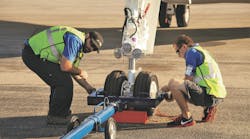Not knowing is not an excuse
By Jim Sparks
Good, bad, or otherwise, nothing goes on forever. This of course applies to the rules and regulations that govern aviation. As new technology becomes a part of our industry and those in rule-making capacities learn the benefit, in many cases rules change.
Just look at all the advancements in only 100 years. Back in the days of Orville and Wilbur Wright there was no need for devices like cockpit voice recorders and issues such as airspace congestion just could not exist. Too many aircraft in the skies, who would ever have thought that aircraft would routinely fly in the area of 30,000 to 40,000 feet above the ground, much less having to decrease the vertical spacing between them to accommodate yet more traffic?
Other issues including Emergency Locator Transmitters (ELT), terrain awareness, traffic collision avoidance, and Mode-S transponders are all issues that we, the ones entrusted to keep the flying public flying safely, are required to know in order to make sure the machines in our trust and care meet current industry standards or government stipulations. Although the issue of keeping aircraft compliant is supposed to fall on the shoulders of the operator, it is still the responsibility of those of us in the maintenance profession to maintain surveillance and apply proper procedures and techniques as applicable with the evolving equipment and accompanying rules and regulations.
One of the first issues is the implementation of the new rules governing U.S. Federal Aviation Administration certified Repair Stations. Although these changes were made and published in August 2001 they are to go into effect in April of this year. The changes impact FAR Part 91, 121, 135, and 145 operations and those persons involved should be sure to review the applicable regulations to be aware of what's new. In addition, new rules for reporting service difficulties that were scheduled to go into effect January of this year have been postponed until January 2004. This will allow the FAA to issue a Notice of Proposed Rule Making (NPRM) that is planned to take into account issues brought up by the aviation community on the subject.
Reduced Vertical Separation Minimums
Reduced Vertical Separation Minimums (RVSM) and now Domestic RVSM (DRVSM) across the United States are issues that will impact all of us that work
with aircraft that occupy airspace between 29,000 to 41,000 feet. The requirement is now set to be in place by January 2005 not only across the continental United States but southern Canada as well.
An RVSM flight envelope includes the range of Mach number, weight divided by atmospheric pressure ratio, and altitudes over which an aircraft is approved to be operated in cruising flight within RVSM airspace.
RVSM flight envelopes are defined as follows:
The full RVSM flight envelope is bounded as follows:
(1) The altitude flight envelope extends from FL 290 upward to the lowest altitude of the following:
(i) FL 410 (the RVSM altitude limit);
(ii) The maximum certificated altitude for the aircraft; or
(iii) The altitude limited by cruise thrust, buffet, or other flight limitations.
(2) The airspeed flight envelope extends:
(i) From the airspeed of the slats/flaps-up maximum endurance (holding) airspeed, or the maneuvering airspeed, whichever is lower;
(ii) To the maximum operating airspeed (Vmo/Mmo), or airspeed limited by cruise thrust buffet, or other flight limitations, whichever is lower.
To date FAR 91 has been changed by adding Part 91-706 to address RVSM operation. In fact an entire new appendix has been written to cover applicability.
Appendix G to Part 91 - Operations in Reduced Vertical Separation Minimum (RVSM) airspace
Reduced Vertical Separation Minimum (RVSM) Airspace. Within RVSM airspace, Air Traffic Control (ATC) separates aircraft by a minimum of 1,000 feet vertically between flight level (FL) 290 and FL 410 inclusive. RVSM airspace is special qualification airspace; the Administrator must approve the operator and the aircraft used by the operator. Air Traffic Control notifies operators of RVSM by providing route-planning information. Section 8 of this appendix identifies airspace where RVSM may be applied.
Aircraft will have to qualify for flight in RVSM airspace in one of two categories. That is either Group or Non-Group.
RVSM Group Aircraft. Aircraft within a group of aircraft, approved as a group by the Administrator, in which each of the aircraft satisfy each of the following:
(a) The aircraft have been manufactured to the same design, and have been approved under the same type certificate, amended type certificate, or Supplemental Type Certificate.
(b) The static system of each aircraft is installed in a manner and position that is the same as those of the other aircraft in the group. The same static source error correction is incorporated in each aircraft of the group.
(c) The avionics units installed in each aircraft to meet the minimum RVSM equipment requirements of this appendix are:
(1) Manufactured to the same manufacturer specification and have the same part number; or
(2) Of a different manufacturer or part number, if the applicant demonstrates that the equipment provides equivalent performance.
RVSM Non-group Aircraft. An aircraft that is approved for RVSM operations as an individual aircraft based on determined static source error correction and the ability to comply with all RVSM requirements.
Once the category of qualification is determined, the aircraft operator will have to obtain an approved Airworthiness Document from either the aircraft manufacturer or a design or certification agent such as a repair station with a designated authority. This document may be in the form of a Service Bulletin or Supplemental Type Certificate and will spell out how the aircraft must be configured to operate safely in RVSM airspace.
In addition to required equipment, required inspections to verify proper airflow over static ports will be addressed along with continued maintenance practices. Operating and maintaining an RVSM compliant aircraft brings about some important issues. For example, only components listed in the airworthiness document can be used for replacement parts. The Minimum Equipment List (MEL) can also be impacted. Some aircraft with two Air Data Computers (ADC) have the ability to enable one computer to supply both pilot and co-pilot instruments. Although it may be considered acceptable to dispatch the aircraft in this configuration, it will not be authorized for aircraft operating in RVSM airspace. In addition the time limit for testing the air data system may change. In certain cases the ADC now has to be re-certified every year rather than every 24 months.
Aircrew training is also a prerequisite to obtaining RVSM approval. Training is also available for maintenance technicians that will bring about an awareness of maintenance practices that may have an impact on RVSM operation. In addition, an RVSM operating manual has to be created and among other things must contain a section addressing maintenance practices including specific testing methods and equipment.
Once the airframe along with the crew are deemed RVSM compliant, the local Flight Standards District Office should be notified and a test flight arranged to demonstrate aircraft capability. This flight test can be either a flight over a ground-based monitoring station called a Height Monitoring Unit (HMU) or equipping the aircraft with a portable Global Position Monitoring Unit (GMU) that will precisely determine aircraft altitude. Once altimetry data is obtained it is forwarded to the FAA technical center for evaluation and based on aircraft performance the FAA Letter Of Authorization (LOA) is issued enabling operation in RVSM airspace. In some cases with group aircraft, the demonstration flight can be postponed up to six months or even eliminated based on adequate flight test performance of predecessors.
Reduced Vertical Separation Minimum airspace is also scheduled to be implemented in the Middle East and Asia/Europe south of the Himalayas on Nov. 27, 2003 with operating altitudes to be determined.
Terrain Awareness Systems
Terrain Awareness Systems (TAWS) are another issue with a short time line.
For U.S. registered Part 91 aircraft: Turbine airplanes manufactured on or before March 29, 2002, configured with six or more passenger seats and used in Part 91 operations, must be equipped with a Class B TAWS by March 29, 2005.
For U.S. registered Part 135 aircraft: Turbine airplanes manufactured on or before March 29, 2002, configured with six to nine passenger seats and used in Part 135 operations must have a Class B TAWS installed. Part 135 turbine airplanes with 10 or more passenger seats must be equipped with a Class A TAWS by March 29, 2005.
Terrain Awareness and Warning Systems (TAWS) are considered to be Enhanced Ground Proximity Warning Systems (EGPWS) with the ability to perform geometric calculations to determine well in advance any possibility of an unwanted terrain encounter.
Class A TAWS has to provide three alerting functions along with the basic functions, including:
Forward Looking Terrain Avoidance (FLTA) enabling the system to determine reduced required clearance as when the aircraft is doing an approach to landing. It also has to predict imminent terrain impact with ample margin to allow the crew to react and implement evasive maneuvers.
Premature Descent Alert (PDA) will advise the crew when the aircraft has deviated downward from its predicted vertical path.
Basic Functions of Ground Proximity Warning Systems (GPWS) include:
- Excessive rate of descent.
- Excessive closure rate to terrain.
- Negative climb rate or altitude loss after take-off.
- Flight into terrain when not in landing configuration.
- Excessive downward deviation from the Instrument Landing System Glide Slope.
- Descent of the aircraft to 500 feet above the terrain or nearest runway elevation and provide a voice callout "Five Hundred."
Class A TAWS also requires the installation of a flight deck mounted display, which will place an aircraft symbol on a digital terrain map. This presentation may be included on a weather radar screen or other type of Electronic Flight Instrument System (EFIS) and must include aircraft position information provided by the Flight Management System.
Class B TAWS has the same three alert functions but the basic GPWS functions only have to include:
- Excessive rates of decent.
- Negative climb rate or altitude loss after take-off.
- Descent of the aircraft to 500 feet above ground level or nearest runway elevation with a voice callout "Five Hundred."
The Class B version of this system will not require a flight deck display, however provisions should be made so that a visual indication could be added at a later time.
European-registered airplanes in commercial operations, manufactured on or after Jan. 1, 2003 and having maximum take-off weight of at least 12,500 pounds or more than nine passenger seats must be equipped with a Class A TAWS by Jan. 1, 2003.
Mode-S transponders
Mode-S transponders are also on the worldwide legislative hit parade.
As of March 31, 2004 Upgraded Mode-S transponders with ID (ATC-assigned number down-link) will be required on all new-production aircraft as well as in-service aircraft for all IFR and VFR flights within European Civil Aviation Conference (ECAC) countries. In addition Mode-S enhanced surveillance is scheduled for mandatory phasing in between March 2005 and March 2007, starting first in France, Germany, and the United Kingdom. This will apply to all aircraft operations regardless of country of registration. Upgraded Mode-S transponders with ID (aircraft registration number down-link) will be required after March 31, 2005, on all in-service aircraft for all IFR and VFR flights inside ECAC countries. This does not exempt aircraft registered outside the European community. On an associated note, European registered turbine-powered aircraft with a maximum take-off weight of more than 12,500 pounds or more than 19 passenger seats must have Traffic Collision Avoidance Systems (TCAS II, ACAS II with Change 7). This JAA rule has already been applied to large airplanes operating in Europe (maximum take-off weight of 33,000 pounds or more than 30 passenger seats).
On an even shorter leash are the requirements for Emergency Locator Transmitters (ELT).
On Jan. 1, 2004, Emergency Locator Transmitters will be required in all U.S.-registered jet airplanes involved in nonscheduled operations. Although a wide array of ELT are currently on the market, it should be noted that in 2009, satellite-based monitoring of 121.5-MHz ELTs is scheduled to end in favor of the 406-MHz ELTs.
Hopefully all these changes will provide an increased level of safety in our industry plus it sure looks like many of us will be getting a lot of overtime to get the worldwide fleet compliant within the allotted time.





